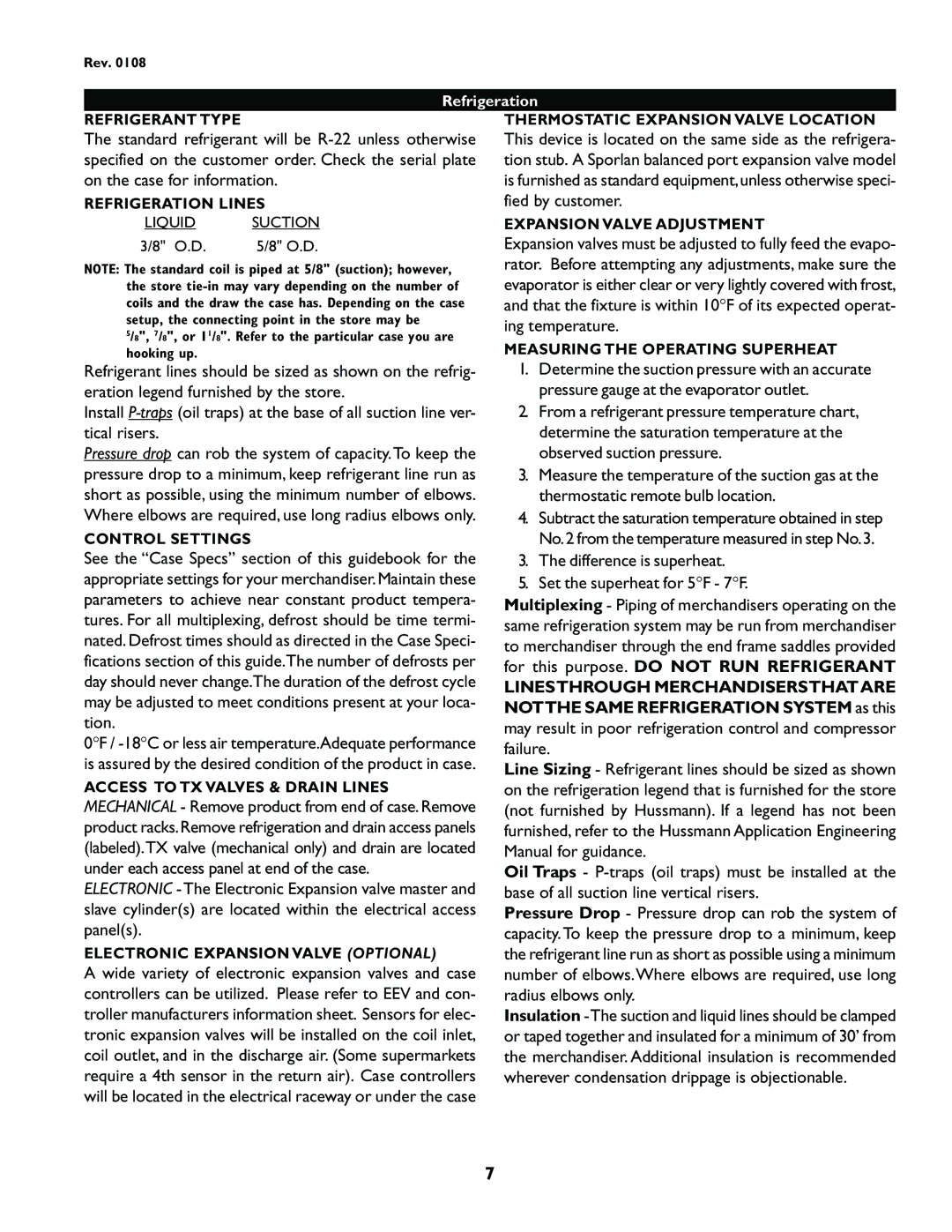Rev. 0108
| Refrigeration |
REFRIGERANT TYPE | THERMOSTATIC EXPANSION VALVE LOCATION |
The standard refrigerant will be
REFRIGERATION LINES
LIQUID SUCTION
3/8" O.D. | 5/8" O.D. |
NOTE: The standard coil is piped at 5/8" (suction); however, the store
5/8", 7/8", or 11/8". Refer to the particular case you are hooking up.
This device is located on the same side as the refrigera- tion stub. A Sporlan balanced port expansion valve model is furnished as standard equipment, unless otherwise speci- fied by customer.
EXPANSION VALVE ADJUSTMENT
Expansion valves must be adjusted to fully feed the evapo- rator. Before attempting any adjustments, make sure the evaporator is either clear or very lightly covered with frost, and that the fixture is within 10°F of its expected operat- ing temperature.
MEASURING THE OPERATING SUPERHEAT
Refrigerant lines should be sized as shown on the refrig- eration legend furnished by the store.
Install
Pressure drop can rob the system of capacity.To keep the pressure drop to a minimum, keep refrigerant line run as short as possible, using the minimum number of elbows. Where elbows are required, use long radius elbows only.
CONTROL SETTINGS
See the “Case Specs” section of this guidebook for the appropriate settings for your merchandiser. Maintain these parameters to achieve near constant product tempera- tures. For all multiplexing, defrost should be time termi- nated. Defrost times should as directed in the Case Speci- fications section of this guide.The number of defrosts per day should never change.The duration of the defrost cycle may be adjusted to meet conditions present at your loca- tion.
0°F /
ACCESS TO TX VALVES & DRAIN LINES
MECHANICAL - Remove product from end of case. Remove product racks.Remove refrigeration and drain access panels (labeled).TX valve (mechanical only) and drain are located under each access panel at end of the case.
ELECTRONIC - The Electronic Expansion valve master and slave cylinder(s) are located within the electrical access panel(s).
ELECTRONIC EXPANSION VALVE (OPTIONAL)
A wide variety of electronic expansion valves and case controllers can be utilized. Please refer to EEV and con- troller manufacturers information sheet. Sensors for elec- tronic expansion valves will be installed on the coil inlet, coil outlet, and in the discharge air. (Some supermarkets require a 4th sensor in the return air). Case controllers will be located in the electrical raceway or under the case
1.Determine the suction pressure with an accurate pressure gauge at the evaporator outlet.
2.From a refrigerant pressure temperature chart, determine the saturation temperature at the observed suction pressure.
3.Measure the temperature of the suction gas at the thermostatic remote bulb location.
4.Subtract the saturation temperature obtained in step No.2 from the temperature measured in step No.3.
3. The difference is superheat.
5. Set the superheat for 5°F - 7°F.
Multiplexing - Piping of merchandisers operating on the same refrigeration system may be run from merchandiser to merchandiser through the end frame saddles provided for this purpose. DO NOT RUN REFRIGERANT
LINESTHROUGH MERCHANDISERSTHATARE
NOTTHE SAME REFRIGERATION SYSTEM as this may result in poor refrigeration control and compressor failure.
Line Sizing - Refrigerant lines should be sized as shown on the refrigeration legend that is furnished for the store (not furnished by Hussmann). If a legend has not been furnished, refer to the Hussmann Application Engineering Manual for guidance.
Oil Traps -
Pressure Drop - Pressure drop can rob the system of capacity. To keep the pressure drop to a minimum, keep the refrigerant line run as short as possible using a minimum number of elbows.Where elbows are required, use long radius elbows only.
Insulation
7
